Biedermeier Furniture:
Form Follows Function
by Bob Brooke
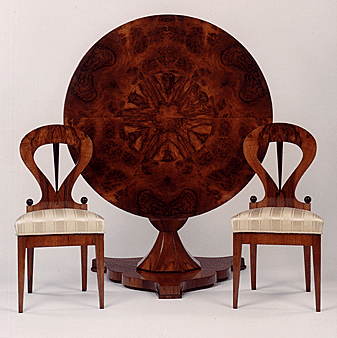 Many people probably believe that the design concept of "form
follows function" began with the Bauhaus in Germany during the
1930s. In fact, it began a century before during the Biedermeier Era in
southern Germany and Austria. A German- based decorative movement which
spread throughout Europe from 1815 to 1848, Biedermeier was a simpler
version of the French Empire and Directoire styles. Many people probably believe that the design concept of "form
follows function" began with the Bauhaus in Germany during the
1930s. In fact, it began a century before during the Biedermeier Era in
southern Germany and Austria. A German- based decorative movement which
spread throughout Europe from 1815 to 1848, Biedermeier was a simpler
version of the French Empire and Directoire styles.
The style’s name derived from Ludwig Eichrodt and Adolf Kussmaul,
who depicted the typical bourgeois of the period under the name "Gottfried
Biedermeier."–"Gott" meaning "God";
fried" meaning "peace"; "Bieder" meaning "commonplace":_meier"
meaning "steward"-- in their Fliegende Blatter (Pamphlets),
a Viennese journal of the day. However, it wasn’t called Biedermeier
until 1886, when Georg Hirth wrote a book about 19th-century interior
design, and used the word "Biedermeier" to describe domestic
German furniture of the 1820s and 1830s.
The Congress of Vienna from 1814 to 1815 had sought to return Europe
to the status quo before the wars. Governments censored publications and
stifled political liberalism. As a result, people cultivated domesticity
and delighted in the details of their surroundings.
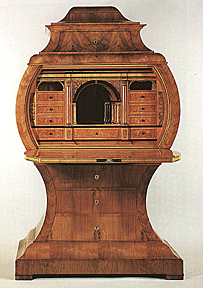 Biedermeier furniture suited the modest size and unostentatious needs
of comfortable bourgeois houses. The new bourgeoises collected
paintings, knickknacks, souvenirs, and gifts ostentatiously displayed in
glass cabinets. Biedermeier furniture suited the modest size and unostentatious needs
of comfortable bourgeois houses. The new bourgeoises collected
paintings, knickknacks, souvenirs, and gifts ostentatiously displayed in
glass cabinets.
During the periods of Rococo and Classicism, a gradual subdivision of
living areas took place. There was a move away from the all-purpose
room, relegating living, cooking, eating, and sleeping to separate
rooms. In middle-class homes, with fewer separate rooms, this concept created the Wohninsel, or "living island." This made
it possible to perform a number of activities in one room--writing,
sewing, music making--each characterized by different furniture, and
quite deliberately separated from the others. Thus, the living room or
as it was known, the salon, was born.
An ottoman, several arm chairs and chairs upholstered in woolen
material, sometimes in silk or damask; then a round table, a mirror and
where possible a glass fronted case for silver and a piano provided the
atmosphere of a "better’ room. The less severe appearance of
Biedermeier furniture led to a less formal arrangement of rooms as a
whole. Flowers, screens, work-tables and knick-knacks of all sorts
helped to give a sense of family life. The bourgeoisie began to form a
personal style, thus creating what’s now known as interior design,
making Biedermeier one of the first design movements to reflect it.
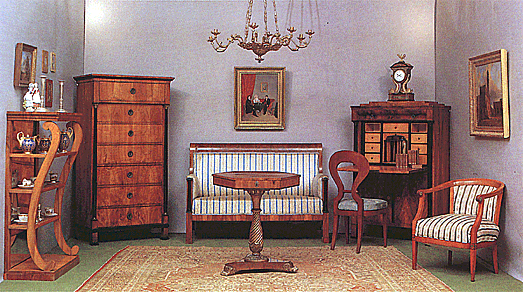
The characteristic suites of furniture were arranged in the
corners--there were areas for eating, for chatting, for reading and
doing embroidery and each would have a sofa, table and chairs, the most
numerous items created.
Prior to 1830, mahogany appeared in Viennese furniture and gradually
replaced walnut. The adoption of this imported wood, which was often
given a light finish, caused some craftsmen to apply matching stains and
finishes to pieces made in walnut, pear wood, and Hungarian
"watered" ash.
And by 1830 Viennese craftsmen no longer relied upon French, German
and Italian designers for inspiration. Native products based upon
Directoire and Empire designs were highly original, showing a good
understanding of form, balance and the use of ornament in gilded bronze.
Attention to economy meant that local timber was mostly used,
especially walnut veneers over a soft wood frame. Inlay served as the
main decorative element, featuring the patterned graining of walnut and
often reduced to a light-colored border. Sometimes, craftsmen used black
poplar or bird's eye maple and colored woods such as cherry and pear
became popular.
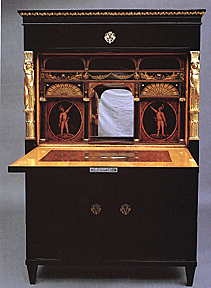 The finer Viennese designs possessed more grace and elegance than the
designs of Bavaria. Viennese craftsmen made drawers and their housings
so perfect and fitted that, even today, when a larger drawer is pulled
out and returned, the other drawers in the same bank will be propelled
forward by the force of air created. They also dovetailed, molded and
finished drawer linings, making intervening partitions flush on top and
paneled beneath. The finer Viennese designs possessed more grace and elegance than the
designs of Bavaria. Viennese craftsmen made drawers and their housings
so perfect and fitted that, even today, when a larger drawer is pulled
out and returned, the other drawers in the same bank will be propelled
forward by the force of air created. They also dovetailed, molded and
finished drawer linings, making intervening partitions flush on top and
paneled beneath.
Cabinetmakers decorated their furniture with black or gold paint, and
often employed less expensive stamped brass wreaths and festoons rather
than bronze for decorative effect and gilded wooden stars instead of the
elaborate metal ornaments of the Empire style. Sometimes, they chose
cheaper, new materials such as pressed paper.
No previous period produced such a wealth of different types of
seating, with a myriad of variations on the basic scheme of four legs, a
seat, and a back. From 1815-1835, Biedermeier craftsmen discovered that
a chair could be given literally hundreds of different shapes.
Upholsterers padded their creations with horse-hair and covered them
with brightly colored velvet and calico. Pleated fabrics covered
furniture, walls, ceilings, and alcoves.
By the 1840s the Biedermeier style became romanticized–straight
lines became curved and serpentine; simple surfaces became more and more
embellished beyond the natural materials; humanistic form became more
fantastic; and textures became experimental.
An identifying feature of Biedermeier furniture is its extremely
restrained geometric
appearance. Some furniture took on new roles; for example, the table
became the family table, around which chairs were set for evening
activities. Or table tops could be placed against the wall in a vertical
position. A portable piano had a drawer for sewing things, while the
upper drawer of a chest of drawers might be converted into a writing
desk.
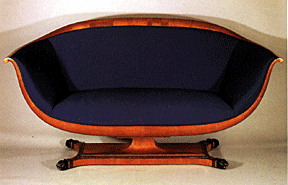 The sofa became one of the most popular innovations. Rectangular,
with high back and sides, sofas looked deceptively hard. In fact, their
depth and solidity made them very comfortable. The sofa became one of the most popular innovations. Rectangular,
with high back and sides, sofas looked deceptively hard. In fact, their
depth and solidity made them very comfortable.
Armchairs, too, became more comfortable as changing fashions
permitted men to sit back and take their ease.
Cabinetmakers used boards as the main element in constructing their
pieces, which meant that they designed furniture to be seen from the
front and executed its ornamentation–relief pillars, pilasters, and
caryatids–with this in mind.
The bourgeoises loved music, thus the ever-present piano, the
polished surface of which became a resting place for clocks, pieces of
porcelain and the inevitable basket of flowers. There was also a vogue
for cabinets to house collections of objects which might proclaim the
artistic sensibility of the household.
Biedermeier comfort emphasized family life and private activities,
especially letter writing– giving prominence to secretary desks. These
featured a central niche, a mirror, and secret drawers. Along with
wardrobes and cupboards, these were the items of furniture most often
made as master works.
To read
more of my articles, please
visit
my Web site.
< Back to Antiques Articles
Next
Article >
|
